Abstract
This report presents studies on ionic currents in Aplysia motoneuron B16 that are modulated by the neuropeptide egg-laying hormone (ELH) of Aplysia. ELH induces an inward current that persists in the presence of the peptide and that decays slowly after ELH is removed from the bath. The effect is not due to a decrease in the delayed potassium current, the calcium-activated potassium current, or the transient potassium current. Current-voltage measurements indicate that ELH produces increased inward currents from -80 mV to approximately equal to 0 mV. The effect is particularly enhanced in the region from -40 mV to -25 mV where a negative slope conductance due to voltage-dependent slow inward current is observed. The slow inward current and the response to ELH persist in saline solutions in which Ca2+ is replaced with Co2+ but are eliminated when Na+ is replaced with equimolar concentrations of either Tris or N-methyl-D-glucamine. The response to ELH is unaffected by replacing chloride with equimolar acetate; by increasing the potassium concentration; or by adding tetraethylammonium chloride, CsCl, 4-amino-pyridine, or tetrodotoxin to the saline bath. In addition, the reversal potentials for the ELH response (range, -28 to +46 mV), obtained from difference current-voltage relationships, are consistent with an increase in the Na+-dependent slow inward current. We conclude that at least one of the effects of ELH on B16 is to increase a slow inward current carried by Na+.
Full text
PDF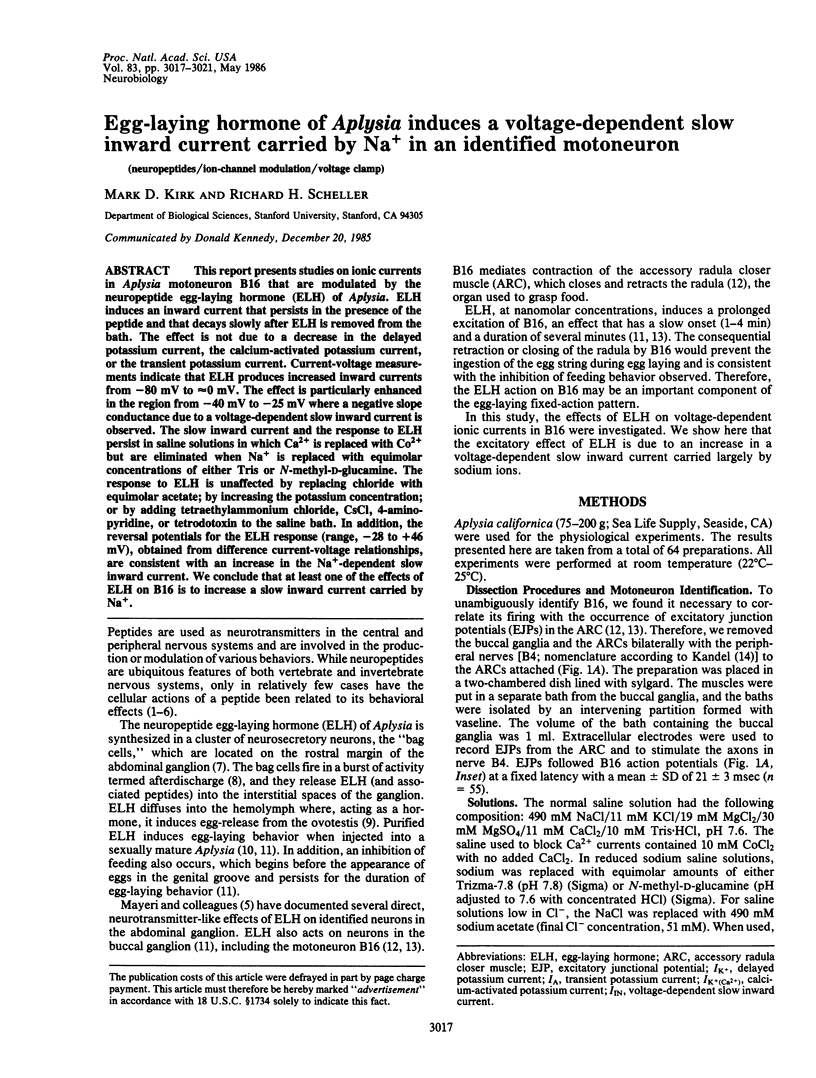
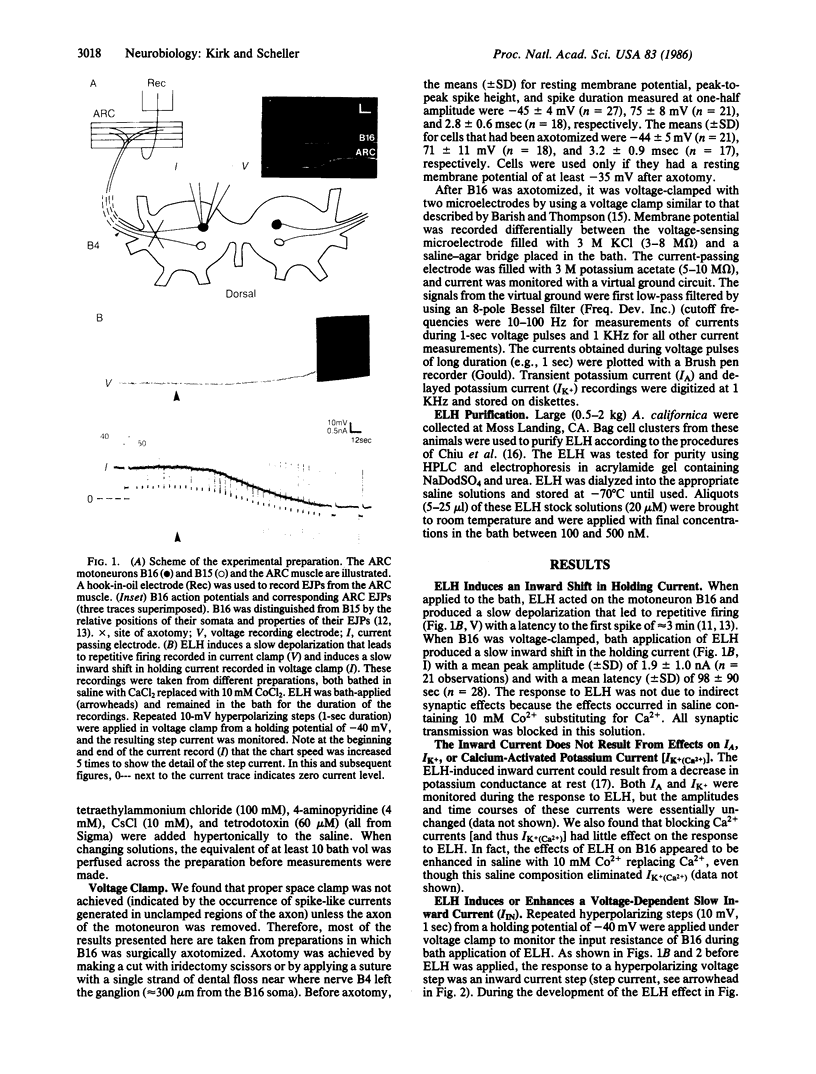
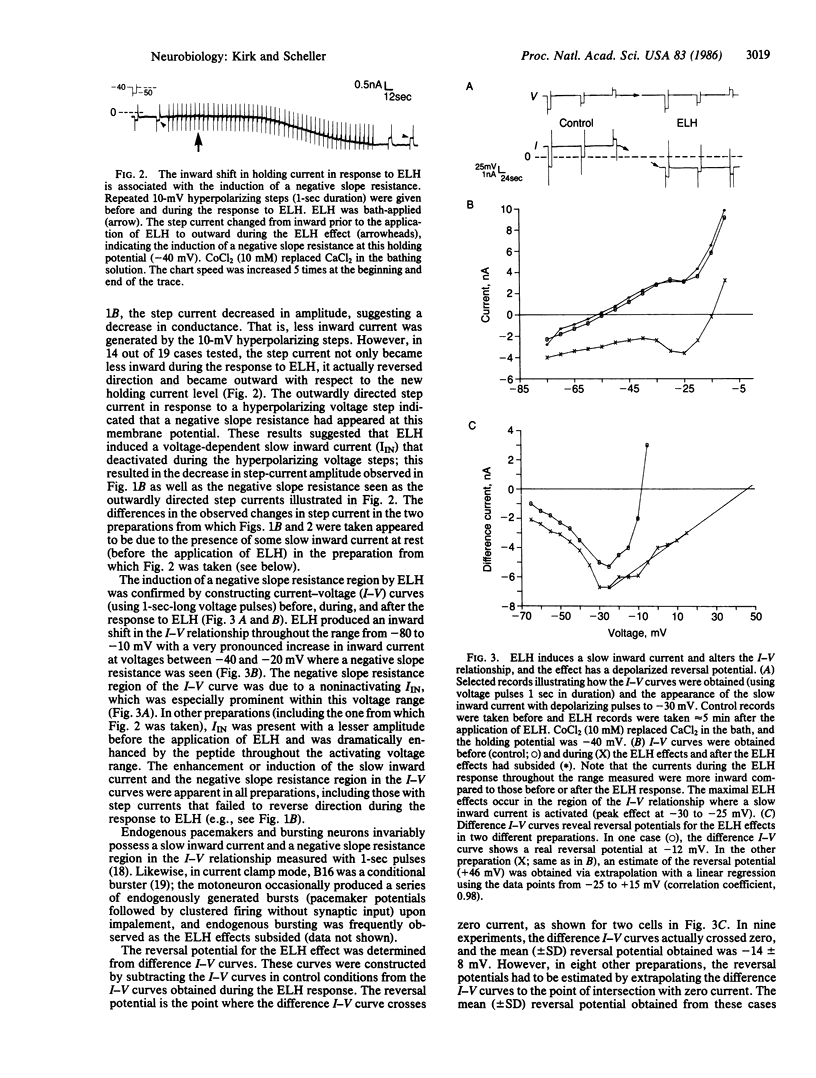
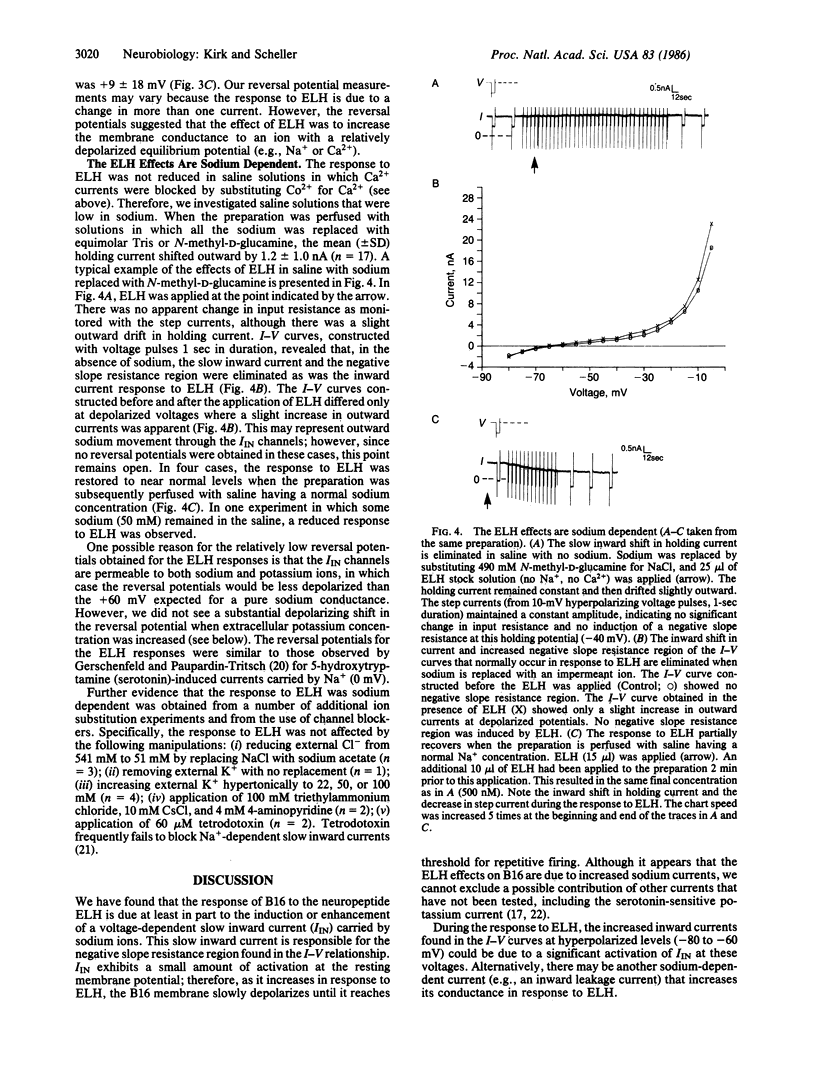
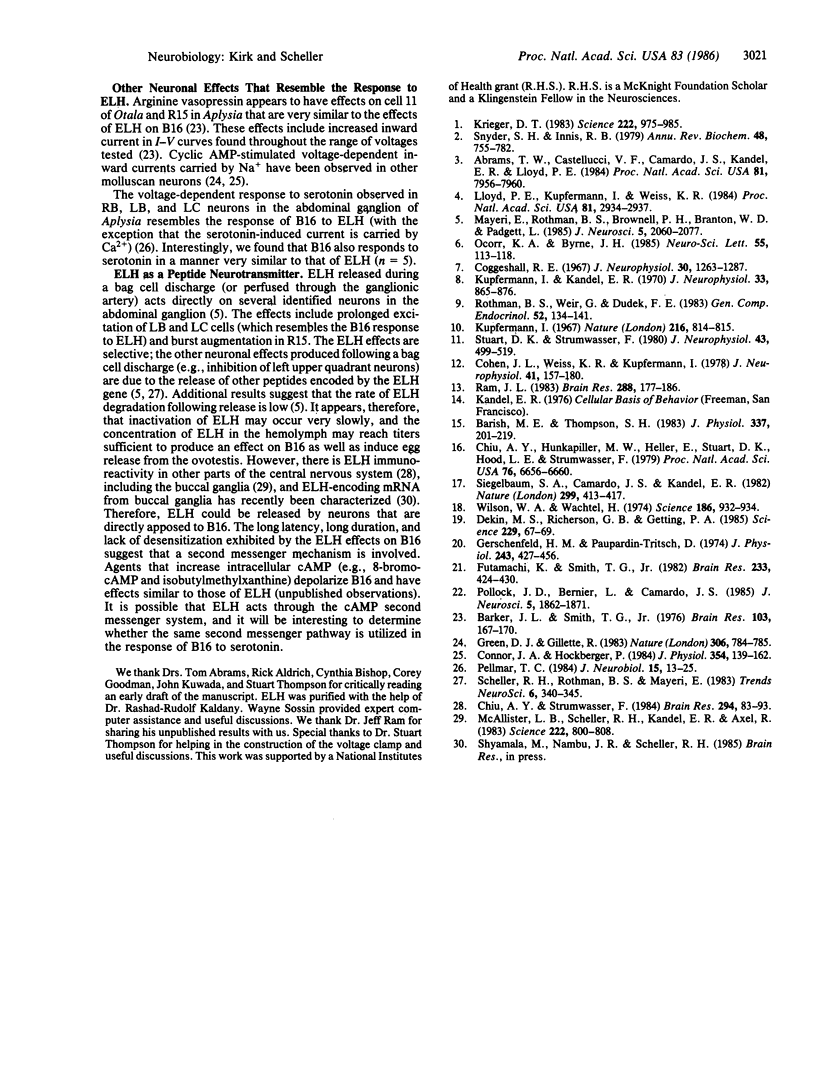
Images in this article
Selected References
These references are in PubMed. This may not be the complete list of references from this article.
- Abrams T. W., Castellucci V. F., Camardo J. S., Kandel E. R., Lloyd P. E. Two endogenous neuropeptides modulate the gill and siphon withdrawal reflex in Aplysia by presynaptic facilitation involving cAMP-dependent closure of a serotonin-sensitive potassium channel. Proc Natl Acad Sci U S A. 1984 Dec;81(24):7956–7960. doi: 10.1073/pnas.81.24.7956. [DOI] [PMC free article] [PubMed] [Google Scholar]
- Barish M. E., Thompson S. H. Calcium buffering and slow recovery kinetics of calcium-dependent outward current in molluscan neurones. J Physiol. 1983 Apr;337:201–219. doi: 10.1113/jphysiol.1983.sp014620. [DOI] [PMC free article] [PubMed] [Google Scholar]
- Barker J. L., Smith T. G., Jr Peptide regulation of neuronal membrane properties. Brain Res. 1976 Feb 13;103(1):167–170. doi: 10.1016/0006-8993(76)90700-9. [DOI] [PubMed] [Google Scholar]
- Chiu A. Y., Hunkapiller M. W., Heller E., Stuart D. K., Hood L. E., Strumwasser F. Purification and primary structure of the neuropeptide egg-laying hormone of Aplysia californica. Proc Natl Acad Sci U S A. 1979 Dec;76(12):6656–6660. doi: 10.1073/pnas.76.12.6656. [DOI] [PMC free article] [PubMed] [Google Scholar]
- Chiu A. Y., Strumwasser F. Two neuronal populations in the head ganglia of Aplysia californica with egg-laying hormone-like immunoreactivity. Brain Res. 1984 Feb 27;294(1):83–93. doi: 10.1016/0006-8993(84)91312-x. [DOI] [PubMed] [Google Scholar]
- Coggeshall R. E. A light and electron microscope study of the abdominal ganglion of Aplysia californica. J Neurophysiol. 1967 Nov;30(6):1263–1287. doi: 10.1152/jn.1967.30.6.1263. [DOI] [PubMed] [Google Scholar]
- Connor J. A., Hockberger P. A novel membrane sodium current induced by injection of cyclic nucleotides into gastropod neurones. J Physiol. 1984 Sep;354:139–162. doi: 10.1113/jphysiol.1984.sp015368. [DOI] [PMC free article] [PubMed] [Google Scholar]
- Dekin M. S., Richerson G. B., Getting P. A. Thyrotropin-releasing hormone induces rhythmic bursting in neurons of the nucleus tractus solitarius. Science. 1985 Jul 5;229(4708):67–69. doi: 10.1126/science.3925552. [DOI] [PubMed] [Google Scholar]
- Futamachi K., Smith T. G., Jr Action of tetrodotoxin on pacemaker conductances in Aplysia neurons. Brain Res. 1982 Feb 11;233(2):424–430. doi: 10.1016/0006-8993(82)91218-5. [DOI] [PubMed] [Google Scholar]
- Gerschenfeld H. M., Paupardin-Tritsch D. Ionic mechanisms and receptor properties underlying the responses of molluscan neurones to 5-hydroxytryptamine. J Physiol. 1974 Dec;243(2):427–456. doi: 10.1113/jphysiol.1974.sp010761. [DOI] [PMC free article] [PubMed] [Google Scholar]
- Green D. J., Gillette R. Patch- and voltage-clamp analysis of cyclic AMP-stimulated inward current underlying neurone bursting. Nature. 1983 Dec 22;306(5945):784–785. doi: 10.1038/306784a0. [DOI] [PubMed] [Google Scholar]
- Krieger D. T. Brain peptides: what, where, and why? Science. 1983 Dec 2;222(4627):975–985. doi: 10.1126/science.6139875. [DOI] [PubMed] [Google Scholar]
- Kupfermann I., Kandel E. R. Electrophysiological properties and functional interconnections of two symmetrical neurosecretory clusters (bag cells) in abdominal ganglion of Aplysia. J Neurophysiol. 1970 Nov;33(6):865–876. doi: 10.1152/jn.1970.33.6.865. [DOI] [PubMed] [Google Scholar]
- Kupfermann I. Stimulation of egg laying: possible neuroendocrine function of bag cells of abdominal ganglion of Aplysia californica. Nature. 1967 Nov 25;216(5117):814–815. doi: 10.1038/216814a0. [DOI] [PubMed] [Google Scholar]
- Lloyd P. E., Kupfermann I., Weiss K. R. Evidence for parallel actions of a molluscan neuropeptide and serotonin in mediating arousal in Aplysia. Proc Natl Acad Sci U S A. 1984 May;81(9):2934–2937. doi: 10.1073/pnas.81.9.2934. [DOI] [PMC free article] [PubMed] [Google Scholar]
- Mayeri E., Rothman B. S., Brownell P. H., Branton W. D., Padgett L. Nonsynaptic characteristics of neurotransmission mediated by egg-laying hormone in the abdominal ganglion of Aplysia. J Neurosci. 1985 Aug;5(8):2060–2077. doi: 10.1523/JNEUROSCI.05-08-02060.1985. [DOI] [PMC free article] [PubMed] [Google Scholar]
- McAllister L. B., Scheller R. H., Kandel E. R., Axel R. In situ hybridization to study the origin and fate of identified neurons. Science. 1983 Nov 18;222(4625):800–808. doi: 10.1126/science.6356362. [DOI] [PubMed] [Google Scholar]
- Ocorr K. A., Byrne J. H. Membrane responses and changes in cAMP levels in Aplysia sensory neurons produced by serotonin, tryptamine, FMRFamide and small cardioactive peptideB (SCPB). Neurosci Lett. 1985 Apr 9;55(2):113–118. doi: 10.1016/0304-3940(85)90004-7. [DOI] [PubMed] [Google Scholar]
- Pellmar T. C. Enhancement of inward current by serotonin in neurons of Aplysia. J Neurobiol. 1984 Jan;15(1):13–25. doi: 10.1002/neu.480150103. [DOI] [PubMed] [Google Scholar]
- Pollock J. D., Bernier L., Camardo J. S. Serotonin and cyclic adenosine 3':5'-monophosphate modulate the potassium current in tail sensory neurons in the pleural ganglion of Aplysia. J Neurosci. 1985 Jul;5(7):1862–1871. doi: 10.1523/JNEUROSCI.05-07-01862.1985. [DOI] [PMC free article] [PubMed] [Google Scholar]
- Ram J. L. Neuropeptide activation of an identifiable buccal ganglion motoneuron in Aplysia. Brain Res. 1983 Dec 12;288(1-2):177–186. doi: 10.1016/0006-8993(83)90092-6. [DOI] [PubMed] [Google Scholar]
- Rothman B. S., Weir G., Dudek F. E. Egg-laying hormone: direct action on the ovotestis of Aplysia. Gen Comp Endocrinol. 1983 Oct;52(1):134–141. doi: 10.1016/0016-6480(83)90166-1. [DOI] [PubMed] [Google Scholar]
- Siegelbaum S. A., Camardo J. S., Kandel E. R. Serotonin and cyclic AMP close single K+ channels in Aplysia sensory neurones. Nature. 1982 Sep 30;299(5882):413–417. doi: 10.1038/299413a0. [DOI] [PubMed] [Google Scholar]
- Snyder S. H., Innis R. B. Peptide neurotransmitters. Annu Rev Biochem. 1979;48:755–782. doi: 10.1146/annurev.bi.48.070179.003543. [DOI] [PubMed] [Google Scholar]
- Stuart D. K., Strumwasser F. Neuronal sites of action of a neurosecretory peptide, egg-laying hormone, in Aplysia californica. J Neurophysiol. 1980 Feb;43(2):499–519. doi: 10.1152/jn.1980.43.2.499. [DOI] [PubMed] [Google Scholar]
- Wilson W. A., Wachtel H. Negative resistance characteristic essential for the maintenance of slow oscillations in bursting neurons. Science. 1974 Dec 6;186(4167):932–934. doi: 10.1126/science.186.4167.932. [DOI] [PubMed] [Google Scholar]




